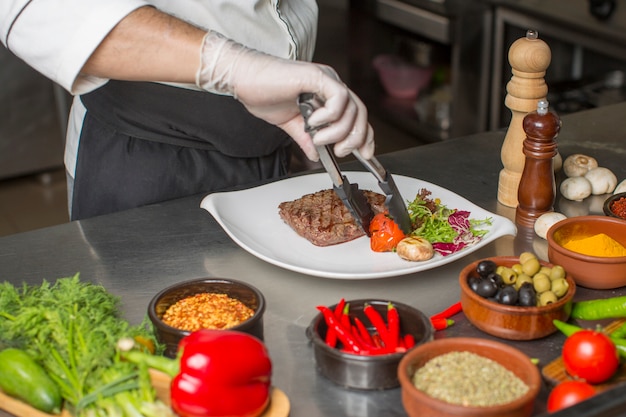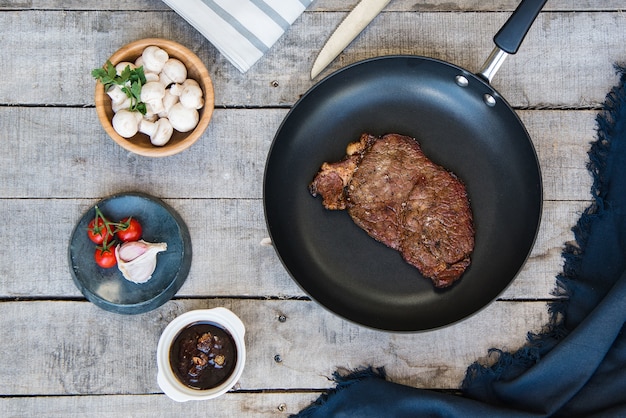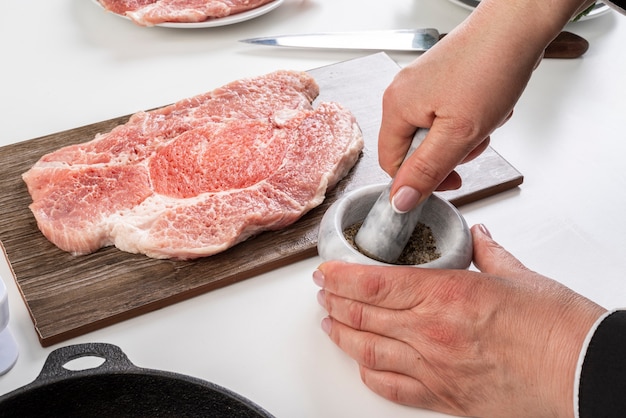Ah, the beef filet. A culinary masterpiece, a symbol of elegance, and the ultimate crowd-pleaser. It’s the kind of dish that makes you feel like a seasoned chef, even if you’re just starting out. But let’s be honest, cooking a perfect filet can be a bit daunting, especially if you’re not a seasoned pro.
That’s why I’m here, armed with years of experience (and a few mishaps along the way) to guide you through the process, step by step. We’ll cover everything from choosing the right cut to mastering the art of doneness, all while keeping the language down-to-earth and the techniques easy to follow. So grab a glass of something delicious, let’s dive in!
(Part 1) Choosing the Right Beef

You know that saying, "you can't make a silk purse out of a sow's ear?" Well, it applies to cooking a filet too. You need the right starting point – a beautiful piece of beef, full of flavour and tenderness. That means picking the perfect cut and grade.
beef cuts and Grades: A Primer
"filet mignon" is just a fancy name for a tenderloin, a long, narrow muscle that runs along the backbone. Think of it like the prime real estate of the cow! Now, within that tenderloin, you have different cuts, each with its own unique character:
center cut: This is the most tender and prized portion. It’s the gold standard for filet mignon, so it’s a bit pricier.
tail cut (Coulotte): This cut is from the tail end of the tenderloin. It has a little more flavour and a bit more texture than the center cut, making it a great value choice.
Then, there’s the grade. This tells you about the quality of the beef based on its marbling – the amount of fat interwoven with the lean meat. More marbling means more flavour and juiciness. Here’s a quick rundown:
Prime: This is the highest grade, with the most marbling and the most flavour. It’s a real treat for your tastebuds!
Choice: This grade is a bit less marbled than Prime, but still a great choice for a delicious filet. It’s a happy middle ground between quality and price.
Inspecting Your Beef: Don’t Be Shy!
You’ve got your chosen cut in hand, so now it’s time to be a discerning shopper. Give it a good look over.
Colour: Look for a deep red colour, with no discolouration or grey patches. This indicates freshness.
Marbling: You want to see a good amount of marbling, those fine streaks of white fat that run throughout the meat. It's what makes your filet melt-in-your-mouth delicious.
Smell: Give it a sniff. The beef should have a fresh, almost sweet aroma. If it smells anything funky, it’s best to pick a different one.
(Part 2) Preparing Your Beef Filet: A Little TLC Before the Heat

You’ve got your beautiful beef, but it’s not quite ready for the pan yet. It needs a little TLC – like a pampered guest getting ready for a grand occasion. This is where we talk about bringing the beef to room temperature, trimming it, and seasoning it to perfection.
Bringing It to Room Temp: Don’t Rush the Romance
This might seem a little counterintuitive, but trust me, letting the beef warm up to room temperature is a game-changer. It helps it cook more evenly, resulting in a more tender and juicy filet. It's like giving your steak a chance to relax and unwind before the main event.
Time: Take your filet out of the fridge and let it sit on the counter for 30-45 minutes.
Don’t Overdo It: Don’t let it sit out for too long, as it can start to spoil.
Trimming the Fat: A Little Sculpting for a Flawless Finish
Most butchers will have already trimmed the filet for you, but a quick once-over never hurts.
Clean Cuts: Use a sharp knife to trim off any excess fat, leaving a thin layer around the edges for flavour. This gives you a smooth surface for even cooking and a more refined presentation.
Seasoning with Love: A Touch of Salt and Pepper Magic
Here’s where you can add your personal touch. I like to keep it simple with salt and freshly ground black pepper. But you can experiment with other spices and herbs:
Spice Ideas: Garlic powder, onion powder, paprika, rosemary, thyme, oregano, even a pinch of cayenne for a touch of heat.
The Less is More Rule: Don't go overboard. You can always add more seasoning later, but taking it away is a little trickier!
(Part 3) Cooking Your Filet: The Grand Finale

This is the moment of truth! The time to transform your raw beef into a culinary masterpiece. We’ll cover two of the most popular methods – pan-searing and grilling.
Pan-Searing to Perfection: A Hot and Fast Affair
Pan-searing is the perfect way to create a delicious crust on the outside while keeping the inside tender and juicy. It’s a bit like giving your filet a luxurious spa treatment, with heat and oil to bring out its best features.
Your Equipment: You’ll need a heavy-bottomed skillet or pan, which helps to distribute the heat evenly.
High Heat is Key: Heat the pan over high heat until it’s smoking hot. This is crucial for creating that beautiful, crispy crust.
Quality Oil: Add a good quality oil, like olive oil or canola oil. It should shimmer as it heats up.
Don’t Crowd the Pan: Carefully place the filet in the hot pan, making sure not to overcrowd it. This ensures that each side gets a nice even sear.
Searing Time: Sear the filet for 2-3 minutes on each side, or until it’s nicely browned.
Finishing Touches: Reduce the heat to medium and continue cooking for another 3-4 minutes, depending on the thickness of the filet, or until it’s cooked to your desired doneness.
Resting Time: Transfer the filet to a plate and let it rest for 5-10 minutes before slicing and serving. This allows the juices to redistribute, resulting in a more tender and juicy steak.
Grilling Goodness: A Touch of Smoky Flavour
If you’ve got a grill going, there’s no better way to add a smoky, rustic flavour to your filet. It’s like a barbecue party on your plate!
Preheat to Perfection: Preheat your grill to medium-high heat. Those grates should be nice and hot!
Oil Those Grates: Lightly oil the grill grates to prevent sticking and ensure beautiful grill marks.
Grilling Time: Place the filet on the grill and cook for 3-4 minutes per side, or until you get those classic grill marks.
Lower the Heat: Reduce the heat to medium and continue cooking for another 3-4 minutes, or until it’s cooked to your desired doneness.
Let it Rest: Transfer the filet to a plate and let it rest for 5-10 minutes before slicing and serving.
(Part 4) Checking for Doneness: A Balancing Act of Heat and Texture
You’ve cooked your filet, but now it’s time to make sure it’s cooked to your liking. There are two popular methods: the trusty meat thermometer and the tried-and-true finger-press method.
Meat Thermometer Magic: The Scientific Approach
The most accurate way to check for doneness is with a meat thermometer. It takes the guesswork out of it and ensures your filet is cooked perfectly, every time.
Placement: Insert the thermometer into the thickest part of the filet, making sure it doesn’t touch any bone.
The Temperature Chart: Here’s a handy temperature chart to guide you:
| Doneness | internal temperature (°F) | Internal Temperature (°C) |
|---|---|---|
| Rare | 125-130 | 52-54 |
| Medium-Rare | 130-135 | 54-57 |
| Medium | 140-145 | 60-63 |
| Medium-Well | 150-155 | 65-68 |
| Well Done | 160 | 71 |
The Finger-Press Method: A Touch of Old-School Charm
If you don’t have a meat thermometer, you can always use the finger-press method. It’s a bit less precise, but it can still give you a good idea of the doneness.
The Technique: Gently press the filet with your finger.
The Feel:
Rare: Feels firm and bouncy.
Medium-Rare: Feels slightly firmer.
Medium: Feels even firmer.
Well Done: Feels very firm, almost hard.
(Part 5) Resting Your Beef: A Well-Deserved Timeout
Your filet is cooked to perfection, but before you jump straight into slicing and serving, let it rest for 5-10 minutes.
Why It Matters: This gives the juices a chance to redistribute throughout the meat, resulting in a more tender and juicy filet. It’s like letting the flavours settle and meld before you enjoy them.
(Part 6) Slicing and Serving: The Grand Reveal
The moment of truth has arrived! Time to unveil your culinary creation.
Slicing Tips: A Matter of Precision
Sharp Knife: Use a sharp knife for clean, even slices. A dull knife will result in ragged cuts and a less appealing presentation.
Against the Grain: Slice the filet against the grain. This helps to break down the muscle fibers, making the meat easier to chew.
Slice Thickness: Slice the filet into ??-inch thick pieces. This is a good size for serving and allows each slice to retain its juiciness.
Arrange Beautifully: Arrange the slices artfully on a platter for an elegant presentation.
Serving Suggestions: A Symphony of Flavours
You’ve got a beautiful, juicy filet, now it’s time to complete the masterpiece. Here are a few ideas for sides that complement the filet perfectly:
Roasted Vegetables: Asparagus, broccoli, Brussels sprouts, carrots, or even sweet potatoes, roasted until tender and slightly caramelized.
Creamy Sides: mashed potatoes or creamy polenta provide a comforting counterpoint to the richness of the filet.
Fresh and Light: A simple green salad with a light vinaigrette brings a refreshing contrast to the rich flavors.
Sauces: A rich red wine sauce, a simple butter sauce, or a mushroom duxelles add a touch of elegance and depth to the dish.
(Part 7) Taking it to the Next Level: Adding Flair and Finesse
You’ve mastered the basics, now let’s take your skills to the next level! A little flair goes a long way when it comes to impressing your guests.
Adding a Finishing Touch: A Touch of Elegance
Herb Butter: Mix softened butter with fresh herbs like rosemary, thyme, or parsley, and spread it on top of the filet before serving.
Pan Sauce: Deglaze the pan after cooking the filet with a little wine or broth, then add herbs and butter to create a delicious sauce.
Mushroom Duxelles: Sauté finely chopped mushrooms and shallots until they are soft and brown. This rich and flavorful topping adds depth and complexity to your filet.
Peppercorn Crust: Crush black peppercorns and rub them onto the filet before cooking for a bit of spice and texture.
Garlic-Herb Rub: Mix garlic powder, onion powder, paprika, oregano, and thyme for a flavorful rub that can be used as a base or mixed with other spices to create a unique rub.
(Part 8) Making it a Meal: A Complete Culinary Experience
A delicious filet is just the start! Now, let’s create a complete dining experience that wows your guests from start to finish.
Wine Pairings: A Symphony of Flavors
A well-chosen wine enhances the flavours of your filet and creates a harmonious dining experience.
Cabernet Sauvignon: This full-bodied red wine is a classic pairing for beef. Look for wines with notes of black currant, cedar, and vanilla.
Merlot: This smooth and elegant red wine is a great option for medium-rare to medium fillets. It has notes of black cherry, plum, and chocolate.
Pinot Noir: If you’re serving a filet mignon with mushrooms or a rich sauce, Pinot Noir is a wonderful choice. Look for wines with notes of red fruit, earthiness, and spice.
Zinfandel: This bold and fruity red wine is a good choice for a more robust filet mignon. It has notes of black pepper, blackberry, and jam.
The Presentation Matters: A Visual Feast
A beautifully presented dish elevates the entire dining experience.
Beautiful Platter: Use a beautiful platter or serving dish to showcase your culinary creation.
Artful Arrangement: Arrange the filet slices artfully on the plate, creating a visually appealing composition.
Touch of Greenery: Add a sprig of rosemary or parsley for a touch of freshness and colour.
Table Setting: Use a nice tablecloth and napkins to create a sophisticated setting.
(Part 9) Frequently Asked Questions
Here are some answers to common questions about cooking the perfect beef filet.
1. How Long Should I Cook a Beef Filet?
The cooking time depends on the thickness of the filet and your desired doneness. For a 1-inch thick filet, here’s a rough guide:
Rare: 3-4 minutes per side
Medium-Rare: 4-5 minutes per side
Medium: 5-6 minutes per side
It’s always a good idea to use a meat thermometer to check for doneness.
2. Can I Cook a Beef Filet in the Oven?
Absolutely! Cooking a filet in the oven is a great option for larger cuts. Preheat your oven to 400°F (200°C), and roast the filet for:
Rare: 10-15 minutes
Medium-Rare: 15-20 minutes
Medium: 20-25 minutes
Use a meat thermometer to ensure it’s cooked to your desired doneness.
3. How Can I Make My Beef Filet More Tender?
Besides using a tender cut of meat, here are a few tricks:
meat tenderizer: A meat tenderizer helps break down the muscle fibers, making the meat more tender.
Marinating: Marinate the filet in a mixture of olive oil, soy sauce, garlic, and herbs for extra flavour and tenderness.
4. Can I Freeze a Beef Filet?
Yes, you can freeze a beef filet. Wrap it tightly in plastic wrap, then in aluminum foil, and store it in the freezer for up to 3 months. To thaw, transfer the filet to the refrigerator for 1-2 days.
5. What Happens if I Overcook My Beef Filet?
Overcooked beef filet will be tough and dry. To avoid this, use a meat thermometer to ensure it’s cooked to your desired doneness. If you do overcook it, try adding a flavorful sauce or topping to help mask the dryness.
And there you have it, folks! The ultimate guide to cooking the perfect beef filet. Now go forth and conquer the kitchen with your newfound culinary confidence! Happy cooking!
Everyone is watching

Corn on the Cob: The Ultimate Guide to Perfectly Cooked Ears
Healthy MealsAh, corn on the cob. Just the name evokes images of sunny days, barbecues, and that sweet, juicy flavour that ...

Perfect Pork Roast Oven Cooking Time: A Guide to Delicious Results
Healthy MealsThere's something truly satisfying about a perfectly roasted pork. The aroma alone is enough to make your mout...

Ham Cooking Time: How Long to Bake, Smoke, or Boil a Delicious Ham
Healthy MealsAh, ham. It's a classic, isn't it? A real crowd-pleaser, especially around holidays. And when done right, it'...

Scallops: The Ultimate Guide to Perfect Cooking
Healthy MealsAh, scallops. Those delicate, sweet, and utterly delicious morsels of the sea. They hold a special place in my...

Spaghetti Squash: The Ultimate Guide to Cooking and Serving
Healthy MealsRemember that time you saw spaghetti squash at the supermarket, looking all bumpy and strange, and thought, "W...
